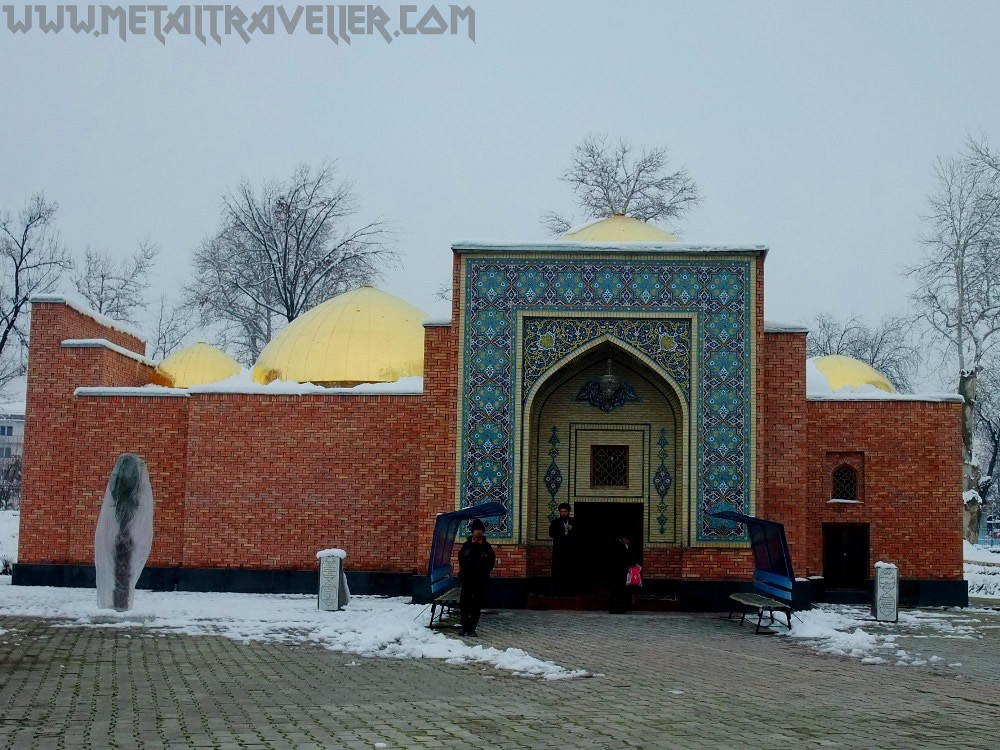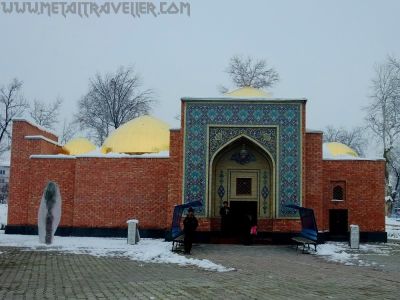

The Mir Sayyid Ali Hamadani Mausoleum in Kulob, Tajikistan, is an important historical site and a place of pilgrimage for many. A guided tour of the mausoleum offers visitors the chance to explore this architectural marvel and learn about its significance. The mausoleum stands as a testament to the region's rich cultural heritage and the influence of Islam in Central Asia. During the guided tour, visitors will hear about the life of Mir Sayyid Ali Hamadani, a Persian Sufi and poet who played a pivotal role in the spread of Islam in Kashmir and Central Asia. The guide will also elaborate on the architectural features of the mausoleum, including its intricate tile work and calligraphy, and its restoration efforts. The tour typically includes visits to the surrounding gardens and the opportunity to pay respects at the mausoleum itself. Participants might also gain insight into the local customs and traditions related to the site.
The Mausoleum of Mir Sayyid Ali Hamadani offers a unique backdrop for photography enthusiasts looking to capture the essence of Tajikistan's historical architecture and spiritual ambiance. It stands as a splendid example of Islamic architecture with its majestic domes, minarets, and intricate geometric patterns. Participants of this activity will be able to take their time framing the perfect shots of the exterior's tiled façade, the ornate doorways, and the interior's detailed artwork. The play of light and shadow in the gardens provides a serene setting for contemplative portraits or landscape photography. Although the mausoleum is the centerpiece, the surrounding landscape and cityscapes of Kulob also provide ample photographic opportunities. It is advisable to respect the sanctity of the site, and photographers should ensure they have permission to photograph inside the premises.
For those interested in delving deeper into the cultural and spiritual practices surrounding the Mir Sayyid Ali Hamadani Mausoleum, a cultural immersion workshop can be a meaningful experience. Such workshops often include an introduction to Sufi traditions, local Islamic practices, and the historical significance of the site. Participants might have the chance to observe or join in prayer sessions, learn about the Sufi approach to spirituality, and understand the influence of Mir Sayyid Ali Hamadani on local customs. The workshops could also cover topics such as the impact of the Silk Road on the spread of culture and religion, and the blend of Persian and Tajik cultural elements in the region. Workshops are a great venue for engaging discussions and intercultural exchange, and they may be led by local scholars or religious leaders who can provide unique personal insights into the mausoleum's legacy.
The mausoleum showcases exquisite examples of Islamic calligraphy and tile work which are essential elements of its aesthetic appeal. For those interested in arts and crafts, participating in a calligraphy and tile work class can be a fascinating activity. Led by local artisans who maintain the traditions passed down through generations, participants will learn about the techniques and patterns used in creating the stunning decorations seen throughout the mausoleum. The classes provide a hands-on opportunity to try your hand at creating traditional designs, understanding the symbolic meaning behind the motifs, and perhaps even crafting a small piece to take home as a souvenir. This activity can offer a deeper appreciation for the skill and creativity involved in adorning such historical sites and help promote the preservation of these traditional arts.
Attending an evening prayer and Sufi chanting session at the Mir Sayyid Ali Hamadani Mausoleum is an activity that offers an immersive spiritual experience. Visitors are welcome to observe the prayer rituals and listen to the melodic chanting, which are central to the Sufi practices observed at the mausoleum. Such experiences allow visitors to experience the serenity and depth of Sufi mysticism, offering a peaceful respite from the bustle of everyday life. It also provides an insight into the communal and devotional aspects of local religious practice. The chanting is often accompanied by traditional musical instruments, enhancing the spiritual ambiance. Visitors should be respectful of local customs and dress modestly. The atmosphere during these sessions can be one of profound tranquility and introspection, and many find it a highlight of their visit to Kulob.
Exploring the local cuisine is an essential part of visiting any new region, and Kulob offers a variety of traditional Tajik dishes for visitors to try. Attending a local cuisine tasting activity near the Mir Sayyid Ali Hamadani Mausoleum allows visitors to indulge in the tastes of Tajikistan while absorbing the historical atmosphere. The tasting might include dishes such as qurutob, a traditional bread-based dish served with a tangy yogurt sauce, or plov, a hearty Central Asian rice dish often cooked with carrots, onions, and meat. Visitors may also sample various types of kebabs, dumplings like manti, and an array of sweet pastries. Sampling these dishes in the context of the mausoleum’s history can enrich the culinary experience as visitors learn about the influences that the Silk Road had on the local food culture.
Visitors to the Mir Sayyid Ali Hamadani Mausoleum can complement their historical exploration with a visit to a nearby artisan market. Such markets are vibrant places where local craftspeople sell handmade goods that reflect the region's rich artistic heritage. Shoppers might find intricately woven textiles, handcrafted jewelry, traditional Tajik hats (tubeteikas), and a variety of other souvenirs. Exploring the market presents an opportunity to connect with local artisans, learn about their crafts, and witness the skill involved in their work. Additionally, the markets often feature stalls with local snacks and delicacies, making for a well-rounded cultural experience. Participating in a visit to the artisan market not only supports the local economy but also allows visitors to take a piece of Tajik culture home with them.
For history buffs and those intrigued by the stories of peoples and places, a historical lecture series at or near the Mir Sayyid Ali Hamadani Mausoleum can provide a deeper understanding of the site's significance. The lectures might be given by historians, architects, or religious scholars, and cover topics such as the life and influence of Mir Sayyid Ali Hamadani, the architectural evolution of the mausoleum, and the history of Kulob and the surrounding region through the ages. Such talks can offer nuanced perspectives on the area’s development, the Silk Road’s impact, and the cultural exchanges that have shaped local traditions. The lecture series is not only educational but can also be a platform for dialogue and exchange among participants from around the world.
Witnessing the sunrise or sunset at the Mir Sayyid Ali Hamadani Mausoleum provides a chance to see the site in a unique light, quite literally. The soft morning or evening sun offers a serene moment to appreciate the mausoleum’s architecture as it is gently illuminated, casting long shadows and highlighting the textures of the tiles and brickwork. During this time, the sky's changing colors provide a beautiful contrast to the earthen hues of the building. Sunrise viewing might attract early-risers seeking a tranquil start to their day, whereas sunset viewing is perfect for those wanting to reflect on the day's experiences. Both times offer good opportunities for photography or simply for enjoying a moment of peaceful contemplation. As these are often quieter times at the mausoleum, visitors can take advantage of the less crowded atmosphere.
Visiting the Mir Sayyid Ali Hamadani Mausoleum after dark can be a captivating and atmospheric experience. Typically on special occasions or during certain times of the year, the mausoleum is lit up at night, showcasing its magnificent structure against the night sky. The play of light on the building's façade emphasizes its architectural details, such as the minarets and domes. During the nighttime illumination, the mausoleum becomes a beacon of heritage and history that can be seen from afar, drawing visitors and locals alike to witness its splendor. This experience allows for a different perspective on the mausoleum and can be a memorable way to appreciate Tajikistan's historical monuments. The illumination often carries symbolic significance, representing the enduring cultural and spiritual legacy that the mausoleum represents.
